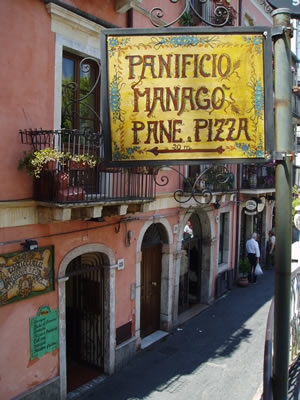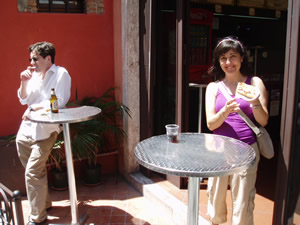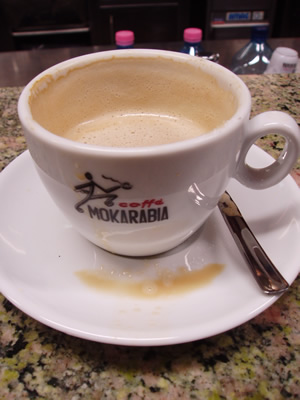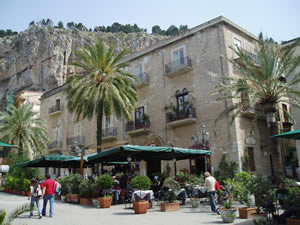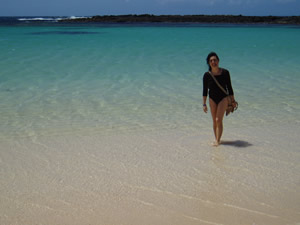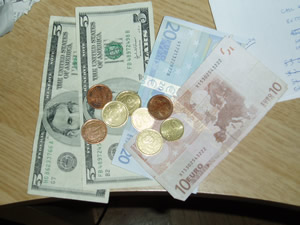By Andrew Hood
Italian lessons II: Eating on the run
June 12, 2008 —
Eating in Italy almost feels like a sin.
It’s so good, so delicious, so pleasing to all the senses that it almost makes you feel guilty.
The biggest peccadillo, however, is missing out on the authentic Italian experience and getting trapped by hit-and-run restaurants plying the rich tourist trade.
Whether you’re in Venice, Florence or the Costa Amalfi, if there’s a view, there’s a very good chance that the food won’t be very good.
Sure, the spaghetti pomodoro will seem pretty damn good compared to what you get from your local Carrabba’s Italian Grill, but it will pale in comparison to the gems packed full of locals, usually just around the corner.
Eating doesn’t come cheap in Italy these days, but there are ways to stretch the dollar to save up to make the splurges really count.
Just as it will cost you more to sit down to sip your coffee, you pay a premier to sit for a meal.
For those willing to take their meals on the run, there are plenty of affordable and tasty options to save some money and still get a great meal at a discount.
Italy is full of little family-run shops, called paninoteca, selling panini, focaccia and mini pizzas sold by the weight.
One of our best meals was during a recent visit to Sicily. We bought two slices of pizza topped with fresh olives and tuna and a Diet Coke for five euros. The owner even gave us a sampling of the local desert for free.
We walked outside and sat on the steps of the duomo at Siracusa (yeah, from Syracuse fame) and gobbled it down, enjoying the same view the tourists were paying 15 euros for their pizza-with-a-view in the restaurant across the piazza (not to mention the coperta).
If you do decide to eat a restaurant, and of course you will, because you won’t eat better in your life than in Italy, keep an eye out for trattorias and local eateries packed with Italians. Skip the restaurants full of tour groups and search out the family-run restaurants that are frequented by locals.
One of our favorite ways to hunt out restaurants is ask the hotel receptionist where they go to eat when they head out with friends. They might suggest a few touristy joints with views, but press them on the best pizza in town, and they’ll typically steer you toward a local place with great ambiance, reasonable prices and fantastic food.
Some restaurants will offer fixed-price menus – called prezzo fisso – that typically include a starter, a main dish, bread, wine or beer and sometimes desert, usually for less than 20 euros. Order all that a la carte and it will almost be double.
Almost every restaurant will have a coperta, a cover change, which is usually between one and two euros per person. No one has been able to effectively explain to me what purpose the coperta serves, other than to stuff the pockets of the owners. Some say it’s one way to help pay the waiters, but they’re still always chirpy at the end of the meal hoping for a handout from the rich tourists.
I’ve seen even the most level-headed travelers get cross-eyed when they realize they have to pay an extra 8 euros for the coperta with a party of four on top of the meal price, but as in all things in Italy, read the fine print.
Some restaurants even charge extra for bread on top of the coperta, but I’ve only seen that once and it’s usually a tell-tale sign that it’s a tourist, rip-off joint.
Another way to save money is to skip the heavy sell for bottled water and ask for tap water instead. That will save you at least 3 euros per bottle.
Also, ask for vino de casa – house wine – instead of bottled wine. A half-liter of good-quality house red will usually be less than 5 euros while most bottles of Italian reds start north of 10 euros per bottle.
Next time, we’ll go through the elaborate ritual of eating Italian-style, from the aperitivo to the digestive – and all the good stuff in between.
![]() Submit a comment on "Italian lessons II: Eating on the run"
Submit a comment on "Italian lessons II: Eating on the run"
By Andrew Hood
Italian lessons, Part I: Coffee-time, Roma-style
May 28, 2008 —
When you’re ready for a coffee in Rome, don’t do like the tourists do.
Sure, it’s off-the-charts romantic to sit in a piazza in front of the 2,000-year-old Pantheon and soak up its pulsating history while sipping a frothy cappuccino.
But in these days of the ever-shrinking dollar, it’s wise to watch the locals.
How do the Romans do it? They sip their coffee at the bar and leave the sight-seeing for the evening passegiata, or stroll.
For most Italians, the idea of sitting down for a coffee is as alien as drinking their cherished beverage from a plastic to-go cup. It just doesn’t bridge the cultural gap, no matter how many Starbucks keep sprouting up in Milan, Rome and Florence.
For the authentic (and more economical) coffee experience, sip your brew on your feet. Italians drink their coffee fast, fresh, hot and at the bar. Standing up, usually reading the morning paper as well.
Almost all those terraces and outdoor cafes in the heart of any Italian historic district will be loaded with American, Brit and Japanese tourists. It’s not that the locals don’t love their monuments, it’s just they know how to enjoy them without paying through the nose for the view.
Here’s how you get your coffee, Italian-style:
First, go to the cassa, or cashier, usually near the entrance of the bar. Lay down your euros and say what you want. Grab the receipt and walk to the bar. The barman might ask you what you want or simply look at the receipt. Putting a 10- or 20-cent coin on top of the receipt as a tip for the barista typically speeds up the process.
Then it’s bam-boom-blam, and your freshly prepared, piping-hot coffee is presented to you in a flourish only the Italians can muster, typically with a nice touch of a signature twirl of the froth atop your cappuccino. Add sugar, suck it down, and off you go.
If you want that brew with a view, however, it won’t come cheap. The general rule is, the further you are from the bar, the more it’s going to cost you.
A cappuccino (only taken at breakfast, by the way) typically sets you back between 1 and 1.50 euros, depending on the establishment. At the famous Sant'Eustachio café, just around the corner from the Pantheon, a cappuccino at the bar costs 1.25. Take it sitting down inside, double the price. Order it while sitting in one of those cafés facing the Trevi Fountain, expect to pay up to 5 euros.
Sometimes a splurge when you do get to those postcard moments is simply worth it.
Traveling to Italy is a sensory experience, and there’s nothing better than admiring the handiwork of a Roman architect from two millenniums ago while enjoying the handiwork of today’s best coffee artisans.
Those 6 euro cappuccinos seem like a bargain when you’re sitting with a view of a 2,000-year-old intact Roman temple.
Just don’t do the conversion back to dollars. It might give you indigestion.
Andrew Hood is in Italy all month covering the Giro d’Italia. He gets his morning coffee standing at the local bar with a copy of La Gazzetta dello Sport in arm.
![]() Submit a comment on "Italian lessons, Part I: Coffee-time, Roma-style"
Submit a comment on "Italian lessons, Part I: Coffee-time, Roma-style"
Save a buck traveling Euro-style
April 16, 2008 —
For anyone heading to Europe this mud season, consider buying into one of the all-inclusive package deals that the Euros love more than parliamentary elections and national strikes.
Like most Vailians, I used to cringe at the thought of any type of package tourism. The further off the beaten track the better. But tight work schedules and the ever-increasing costs of searching out affordable yet comfortable accommodation drove me to the dark side of Euro-trash package deals.
My wife and I used to love traveling on a whim, finding funky hotels, B&Bs and rustic inns, but we’ve found these options harder and harder to secure without hemorrhaging major cash flow. We’re too old for youth hostels, but those charming B&Bs that make it onto the covers of Conde Naste break our travel budget these days.
A few years back, my wife finally convinced me to try a package deal. We chose Menorca, one of Spain’s charming Balearic islands, and the price couldn’t be beat. The $259 price tag included a round-trip flight from Madrid, a transfer to the hotel, a week’s accommodation, and breakfast and dinner each day. We were on our own for drinks and lunch, but the overall positive experience changed my mind.
To get away from the crowds, we rented a car and searched out the island’s world-class beaches that dot the still-wild Mediterranean Coast before returning to our hotel each night to gorge on the all-you-can-eat buffet.
Sure, it was one of those horrendous block-style hotels built in the 1980s, but the facilities were adequate, the food more than passable and the affordable package price allowed us to splurge on those postcard-moment romantic dinners down by the port without having to break out the abacus to calculate the damage to our budget.
Since then, we’ve traveled to Mallorca, Ibiza, Tenerife, Lanzarote, Tunisia and Gran Canaria with half-board package deals. We’ve never paid more than $500 each for flight, hotel, transfers and meals.
By mixing in a cheap car rental and working in some day trips to get away from the hordes of German and English tourists, it’s actually our preferred way to travel when we want to squeeze in an affordable week on the beach somewhere.
When we’ve gone back to U.S.-style road trips and paid separately for accommodation and meals, it’s typically cost us close to double what we would have with a package deal.
If you’re heading to Europe, check out travel web pages catering to Europeans and book a trip leaving from some major European capital once you get on this side of the pond. Some of the ones we regularly check from Spain are www.viajar.com, www.ebookers.es and www.rumbo.es. Most have English-language links.
Despite the tanking dollar against the Euro, it’s still cheaper to book something in Europe. If you’re not comfortable booking online for a foreign country, just head into a travel agency for last-minute deals once you land.
We booked a trip to Fuerteventura, one of Spain’s spectacular Canary Islands, with just a week’s notice.
As I write this now, I’m sitting on a terrace overlooking the turquoise waters off the Fuerteventura coast. My wife is down there on the beach somewhere, probably pretending to be ignoring the admiring glances of Italian vacationers.
This time I was even induced to make the full leap into Euro tackiness and buy into one of the “all-inclusive” deals.
It’s the same as half-board with the additional lunch and all drinks included. Our trip cost 450 euros each, about $675 each with the exchange rate. We’ve spent maybe $5 on some beers one night down by fishing port and another $20 on a lunch during an all-day excursion, otherwise we’ve been indulging ourselves on Euro-style comfort food buffets.
We’re in a modern, four-star complex with 500 rooms, three swimming pools, two buffet restaurants, a gym, spa, five bars, all built on terraced gardens on the side of an ancient lava flow overlooking Europe’s most spectacular beaches.
There’s even open bar until 11 every night. The line gets quite long as the French, Brits, Spaniards and the odd Russian jostle to get that last drink before they start charging.
It’s a great way to practice your languages, though I still haven’t learned how to say, “back of the line, pal” yet in German.
![]() Submit a comment on "Save a buck traveling Euro-style"
Submit a comment on "Save a buck traveling Euro-style"
By Maria Jesus Hood
The incredible shrinking dollar
March 26, 2008 — The almighty dollar isn’t so mighty these days.
The dollar continues to slide against the world’s major currencies, with the English pound recently hitting the 2-to-1 threshold while the euro – introduced in 2002 in 10 European nations – hit an all-time high at 1.59 to the dollar.
When the euro was first introduced in 2002, it was trading about 84 cents to the dollar, so in just six years, the U.S. currency has lost nearly half of its value in Europe.
Things are downright ugly for Europe-bound travelers packing greenbacks. A hotel that costs 100 euros translates to $159 a night. Sucking dollars out of ATM machines is worse than going to the dentist. Extracting 300 in euros will set you back a painful $570 (not including bank fees, of course).
The sliding dollar is sure to put a cramp on travel plans this summer. I know many of my friends and relatives have postponed plans for trips to Spain until the dollar heats up.
It wasn’t always like this, of course. The dollar used to be king.
I remember back in the go-go days of the late 1990s, one buck used to fetch a nice pile of Spanish pesetas when it traded at around 210 to one dollar.
I was living high on the hog, indulging in all the culinary delights of Europe, all on the cheap. My wife and I used to dine out three or four times a week, simply because it was ridiculously inexpensive and it was almost cheaper than buying groceries.
Not anymore. Dinners out that used to cost $25 are adding up to 60 euros (almost $100 when converted to dollars), so we’re lucky to dine out once a week.
Things got worse during the botched conversion from Europe’s old monetary notes of francs, liras and pesetas to the universal euro.
In the run-up to the 2002 introduction of the new currency, the European bank set each respective currency to an official rate pegged to the euro. In Spain, for example, the official rate was at 166 pesetas to the euro. In Italy, it was about 1,600 liras and in France around six franc.
When the euro was introduced, rather than set new prices at the official exchange, regulators left it up to the marketplace and many businesses took advantage of the switch to round up prices.
In Spain it became known as el redondeo.
For example, a café con leche in Spain used to cost 100 pesetas. When the euro was introduced, cafeterias simply rounded up to one euro. Simple enough, but the only problem was that represented a 40 percent price hike overnight.
It was the same all over Europe. In Italy, the reference was a pizza margarita, the traditional cheese and tomato pizza that almost always cost 6,000 liras. With the euro, prices were set at 5 or 6 euros, again a huge price hike.
I still can’t get used to seeing my favorite Spanish appetizer – pulpo a la gallega, or steamed octopus, served with potatoes and lemon slices – that used to cost between 1,200 and 1,400 pesetas now running between 14 to 16 euros.
Salaries, of course, were converted down to the cent. But at least the Europeans are getting paid in euros.
Counting up euro cents and doing the depressing conversation has taken the romance out of being an ex-pat in Europe.
Maybe it’s time to move to Canada, but wait, even the Canadian dollar has pulled to parity with U.S. dollar. Times are tough all over.
![]() Submit a comment on "The incredible shrinking dollar"
Submit a comment on "The incredible shrinking dollar"


